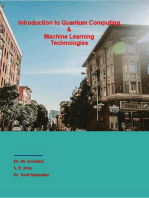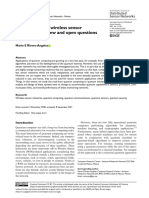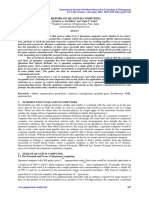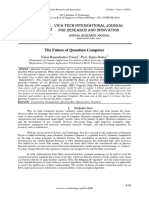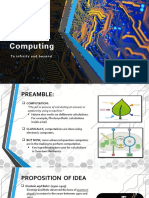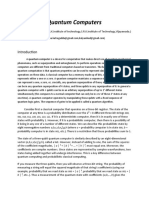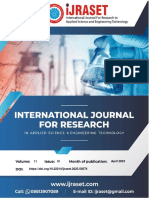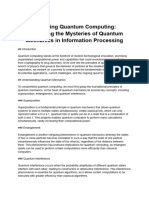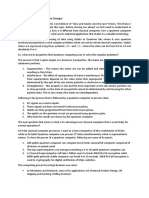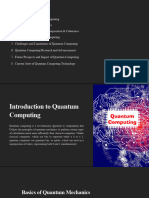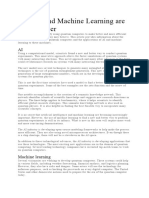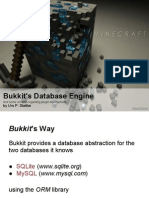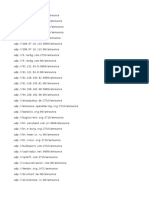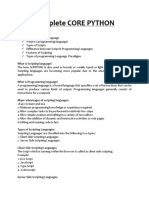Professional Documents
Culture Documents
The Impact of Quantum Computing On Cybersecurity
Original Title
Copyright
Available Formats
Share this document
Did you find this document useful?
Is this content inappropriate?
Report this DocumentCopyright:
Available Formats
The Impact of Quantum Computing On Cybersecurity
Copyright:
Available Formats
Volume 8, Issue 5, May – 2023 International Journal of Innovative Science and Research Technology
ISSN No:-2456-2165
The Impact of Quantum Computing on Cybersecurity
Abhinandan Joshi
Computer Science & Engineering
National Institute of Technology Uttarakhand, India
Abstract:- In the computer based solutions of the combination in quantum computers is defined as
problems in today’s world; if the problem has a high ”Quantum Bit” or ”Qubit”.
complexity value, different requirements can be Electrons have a natural spin formation. It is possible that
addressed such as necessity of simultaneous operation of this format can be changed by taking energy from
many computers, the long processing times for the outside. The quantum computers working according to
operatsion of algorithms, and computers with hardware this principle can transform information by changing the
features that can provide high performance. For this spin order of electrons during the processing of
reason, it is inevitable to use a computer based on information.
quantum physics in the near future in order to make However, another physics principle comes into play in
today’s crypto-systems unsafe, search the servers and such situations: The Heisenberg Uncertainty Principle. It
other information storage centres on internet very proposes that both position and velocity of an electron
quickly, solve optimisation problems in the NP-hard can not be determined at the same time because these
category with a very wide solution space and analyse two states can be transformed into each other. For this
information on large-scale data processing and to process reason, when we examine an electron, it comes out of the
high- resolution image for artificial intelligence state of superposition in which it is found.
applications. In this study, an examination of quantum The logic of the operation triggered by the presence or
approaches and quantum computers, which will be absence of electrical current in conventional computers
widely used in the near future, was carried out and the occurs at atomic size in quantum computers [a]. Qubits
areas in which such innovation can be used was in quantum computers use the quantum circulant method
evaluated. Malicious or non-malicious use of quantum to interact with each other.
computers with this capacity, the advantages and The principle of quantum circulation argues that when
disadvantages of the high performance which it provides two electrons interact with each other, if one of the
were examined under the head of security, the effect of electrons is in a spin-down state, the other must be spin-
this recent technology on the existing security systems up.
was investigated. Understanding how an ordinary process is performed on
quantum computers is the basis for understanding the
Keywords:- Quantum Computer, Security, Cryptography, working mechanism of quantum computers.
Threat. An electron can pass into the superposition state only if it
is not detected by any observation tools or measuring
I. INTRODUCTION instruments. In other words, the electron must not
interact with any physical environment. If the electron is
Quantum computers; are designed to be based on observed, spin state is fixed to that state. Since the
quantum physics rules and can be expressed as computers observer cannot detect two different states of a material
that have the capacity to process more than the processing simultaneously, the mechanism of the changeable
power and computation capabilities of conventional structure is disturbed.
computers Observing the result obtained with a quantum computer
actually requires understanding of the operating principle
Quantum computers, which have a completely different of this device fully. It is enough to obtain a constant
structure from the functioning mechanism of a result from the electrons in the superposition state and to
conventional computer, have the ability to make large- observe these electrons to fix them.
scale calculations conventional computers that can not be The observing process, performed to obtain the result, is
imagined by. called the collapse of the probability wave function in the
In conventional computers, the numbers 0 and 1 are quantum physics and all 2-bit qubits are collapsed and
recorded as electrical currents on very small electronic are interpreted as a single value by the observer. All
circuits. If a circuit carries an electrical current it is qubits which are used depending on the first collapsed bit
expressed as 1, when the circuit does not carry an value, will be formed according to the shape of the first
electrical current, it is expressed as 0. qubit and then the results will be obtained.
In quantum computers, there are 3 different combinations The idea of using quantum computing on computers was
as working principle [a]. Contrary to conventional first put forward by Richard Feynmann in 1959. But even
computers, quantum computers have more states: 1 state, the development of the conventional computers used was
0 state, both 1 and 0 state. This format is called the not completed at that time, therefore this idea was not
superposition in the quantum physics, This triple found applicable in real world. The quantum working
IJISRT23MAY261 www.ijisrt.com 286
Volume 8, Issue 5, May – 2023 International Journal of Innovative Science and Research Technology
ISSN No:-2456-2165
principle use REFERENCES
Social media presence: A strong social media presence [1]. J. A. Silva, T. B. Ludermir, W. R. Oliveira. (2016).
can help your brand reach more people and build Quantum perceptron over a field and neural network
relationships with your target audience. Consider creating architecture selection in a quantum computer, Neural
accounts on platforms like Facebook, Instagram, Twitter, Networks, pp. 55-64.
LinkedIn, and TikTok to promote your brand and engage [2]. M. Gencer, ”Computer Book”, URL:
with potential customers. http://www.mgencer.com/files/Bilgisayartabi.pdf, pp.
21-41.
Search engine optimisation (SEO): Optimising your [3]. G. Arun, V.Mishra. (2014). A review on quantum
website for search engines can help improve your visibility computing and communication, Emerging Technology
in search engine results pages (SERPs). This involves Trends in Electronics, Communication and
researching and incorporating relevant keywords into your Networking, pp. 1-5.
website con- tent, improving your website's loading speed, [4]. I. Sndor, L. Gyongyosi. (2012). Advanced Quantum
and creating high-quality backlinks to your website. Communications: An Engineering Approach. John
Wiley & Sons.
Email marketing: Email marketing is a cost-effective [5]. P. K. Amiri. (2003). ”Quantum computers”, IEEE
way to reach your target audience and promote your brand. Potentials, vol. 21 (5), pp.6-9.
Collect email addresses from your website visitors and use [6]. S. Shamsolah Salemian, S. Mohammadnejad. (2010).
email marketing software to create and send personalised ”An Error-Free Protocol for Quantum Entanglement
emails to your subscribers. Distribution in Long Distance Quantum
Communication”, Communication Systems Networks
Content marketing: Content marketing involves and Digital Signal Processing (CSNDSP), pp. 626-630.
creating and sharing valuable content that informs, educates, [7]. C. P. Williams, S. H. Clearwater. (1998) ”Explorations
or entertains your target audience. This can include blog in Quantum Computing”, Springer-Verlag NewYork,
posts, videos, infographics, podcasts, and more. By Inc. TELOS.
consistently providing valuable content, you can build trust [8]. P. W. Shor. (1994). ”Algorithms for quantum
with your audience and establish your brand as an authority computation: discrete logarithms and factoring”,
in your industry. Proceedings of the 35th Symposium on Foundations of
Computer Science, Los Alamitos, IEEE Computer
Influencer marketing: Collaborating with social media Society Press, pp. 124-134.
influencers can help your brand reach a wider audience and [9]. N. Wiebe, A. Kapoor, K.M. Svore. (2014). ”Quantum
build credibility with your target market. Look for deep learning”. Retrieved from URL:
influencers who align with your brand values and have a https://arxiv.org/abs/1412.3489
strong following in your industry [10]. S. J. Devitt. (2016). ”Performing quantum computing
experiments in the cloud”. Retrieved from URL:
Events and sponsorships: Participating in relevant https://journals.aps.org/pra/abstract/10.1103/PhysRevA
events and sponsoring industry related organisations or .94.032329
causes can help your brand gain exposure and build [11]. K. P. Kumar. (2013). ”PQ key-a novel key generation
relationships with your target audience. Consider attending algorithm for processing big data using quantum
trade shows, hosting webinars, or sponsoring community computing”. Retrieved from URL: http://digital-
events to promote your brand. library.theiet.org/content/conferences/10.1049/cp.2013.
Referral programs: Encouraging your satisfied 2481
customers to refer others to your brand can be a powerful [12]. F. S. Grodzinsky, M. J. Wolf, K. W. Miller. (2011).
way to grow your customer base. Offer incentives like ”Quantum computing and cloud computing: humans
discounts or free products/services to customers who refer trusting humans via machines”, Technology and
others to your business. Society (ISTAS), pp. 1-5.
[13]. H. Singh, A.Sachdev. (2014). ”The quantum way of
In conclusion, there are many ways to promote your cloud computing”, Optimisation, Reliability, and
brand and attract new customers. By implementing a Information Technology (ICROIT) 2014 International
combination of the strategies above and continuously Conference, pp. 397-400.
monitoring and adjusting your marketing efforts, you can [14]. S. Caraiman,V.Manta. (2012). ”Image processing using
effectively reach your target audience and grow your quantum computing”, System Theory, Control and
business. Computing (ICSTCC), 2012 16th International
Conference, pp. 1-6.
[15]. V. Hahanov, V. Miz. (2013).” Quantum computing
approach for shortest route finding”, East-West Design
& Test Symposium, pp. 1-4.
IJISRT23MAY261 www.ijisrt.com 287
Volume 8, Issue 5, May – 2023 International Journal of Innovative Science and Research Technology
ISSN No:-2456-2165
[16]. O. Korchenko, Y. Vasiliu, S. Gnatyuk. (2010).
”Modern quantum technologies of information
security”.
[17]. Shor, P. W. (1994). Algorithms for quantum
computation: Discrete logarithms and factoring.
Proceedings 35th Annual Symposium on Foundations
of Computer Science.
[18]. M. N. Abdullah, M. T. Islam, M. M. Kabir, & M. R.
Amin. (2018). Quantum computing: An overview with
challenges and future prospects. International Journal
of Computer Science and Network Security, 18(6), 94-
101.
[19]. A. E. Rakhmanov, S. S. Knyazeva, D. A. Sidorov, &
V. P. Shkodyrev. (2019). The future of quantum
cryptography in the context of quantum computing.
Journal of Physics: Conference Series, 1270(1),
012102.
[20]. A. R. Calderbank, P. W. Shor, & J. A. Smolin. (1998).
Quantum error correction via codes over GF(4). IEEE
Transactions on Information Theory, 44(4), 1369-1387.
[21]. S. Haroche & J-M. Raimond. (2006). Exploring the
Quantum: Atoms, Cavities, and Photons. Oxford
University Press.
[22]. A. O. Pittenger. (2000). An introduction to quantum
computation algorithms. Progress of Theoretical
Physics Supplement, 139, 77-108.
[23]. A. E. Siegman. (1986). Lasers. University Science
Books.
[24]. R. P. Feynman. (1982). Simulating physics with
computers. International Journal of Theoretical
Physics, 21(6/7), 467-488.
[25]. C. Monroe & J. Kim. (2013). Scaling the ion trap
quantum processor. Science, 339(6124), 1164-1169.
[26]. D. C. McKay, S. Sheldon, J. A. Smolin, & J. M. Chow.
(2019). Efficient Z-measurement calibration for
quantum devices with correlated noise. Physical
Review A, 100(2), 022341.
[27]. Y. Su, W. Li, M. Li, & X. Li. (2019). Image
recognition with quantum-enhanced feature extraction.
IEEE Access, 7, 13846-
[28]. A. G. Fowler, M. Mariantoni, J. M. Martinis, & A. N.
Cleland. (2012). Surface codes: Towards practical
large-scale quantum computation. Physical Review A,
86(3), 032324.
[29]. D. V. Averin & C. Bruder. (2003). Capacitive coupling
of charge qubits. Physical Review B, 67(16), 165322.
[30]. M. A. Nielsen. (2010). Quantum computation with
cluster states. Quantum Information and Computation,
10(1&2), 5-48.
IJISRT23MAY261 www.ijisrt.com 288
You might also like
- Introduction to Quantum Computing & Machine Learning Technologies: 1, #1From EverandIntroduction to Quantum Computing & Machine Learning Technologies: 1, #1No ratings yet
- 5517-Article Text-5625-1-10-20220226Document6 pages5517-Article Text-5625-1-10-20220226SANDHYA RANI N 218002114No ratings yet
- Quantum Computing: A Report FOR MIS207Document10 pagesQuantum Computing: A Report FOR MIS207Alif Anam 1931619630No ratings yet
- SENSORS11Document13 pagesSENSORS11hppavillonNo ratings yet
- Wamukoya 1Document4 pagesWamukoya 1jonathan otienoNo ratings yet
- Quantum Internet - Bushra KhanumDocument22 pagesQuantum Internet - Bushra KhanumMd Shadab AlamNo ratings yet
- A Quantum Review - Cyber Security and Emerging TechnologiesDocument4 pagesA Quantum Review - Cyber Security and Emerging Technologiesmanoj kumarNo ratings yet
- PR - 114 Task 3Document4 pagesPR - 114 Task 3seemaNo ratings yet
- E3sconf Iconnect2023 04041Document9 pagesE3sconf Iconnect2023 04041マルワNo ratings yet
- Submitted To: Submitted By: Dr. Sanjay Bhargav Shweta Rathi Roll No. 35Document20 pagesSubmitted To: Submitted By: Dr. Sanjay Bhargav Shweta Rathi Roll No. 35Ankita BasuNo ratings yet
- The Impact of Quantum Computing On CryptographyDocument6 pagesThe Impact of Quantum Computing On CryptographyIJRASETPublicationsNo ratings yet
- Quantum - Computing (Aditya Raj)Document24 pagesQuantum - Computing (Aditya Raj)Aditya RajNo ratings yet
- Simulation of Any-to-One Communication Protocol For WSN in Cooja PDFDocument23 pagesSimulation of Any-to-One Communication Protocol For WSN in Cooja PDFshubhamNo ratings yet
- Quantum ComputingDocument5 pagesQuantum Computingkentjohnson158No ratings yet
- Wang QuantumComputationQuantum 2012Document23 pagesWang QuantumComputationQuantum 2012ANo ratings yet
- GDC EMEA Whitepaper Quantum-Computing ENDocument17 pagesGDC EMEA Whitepaper Quantum-Computing ENveerajkamath6No ratings yet
- QuantumcloudcomputingDocument11 pagesQuantumcloudcomputingabhichandel704No ratings yet
- A Report On Quantum Computing PDFDocument8 pagesA Report On Quantum Computing PDFVisweswara Rao YedureswarapuNo ratings yet
- Seminar report-GOPIDocument10 pagesSeminar report-GOPIGôpínathNo ratings yet
- Quantum Mechanics and ComputersDocument45 pagesQuantum Mechanics and ComputersMohammed RayaanNo ratings yet
- Nana D 8 C&T CVDocument7 pagesNana D 8 C&T CVRo TechnologiesNo ratings yet
- The Future of Quantum ComputerDocument6 pagesThe Future of Quantum ComputerVIVA-TECH IJRINo ratings yet
- Quantum Computing: Quantum Key DistributionDocument4 pagesQuantum Computing: Quantum Key DistributionInternational Organization of Scientific Research (IOSR)No ratings yet
- QA ReportDocument14 pagesQA ReportProjects BucketNo ratings yet
- ICT PresentationDocument27 pagesICT PresentationMahleeza NisarNo ratings yet
- Quantum ComputingDocument14 pagesQuantum Computingkeethanakeerthana0No ratings yet
- An Essay On Quantum ProcessorsDocument6 pagesAn Essay On Quantum ProcessorsIJRASETPublicationsNo ratings yet
- QC AbstractDocument5 pagesQC Abstract429by3No ratings yet
- Physics Physical Property Interaction QuantizationDocument9 pagesPhysics Physical Property Interaction QuantizationMohammed Abdul RahmanNo ratings yet
- ID135Document11 pagesID135Sulbha GathNo ratings yet
- Vijay Alluri - (1209013) # Report 10 ENGR400Document2 pagesVijay Alluri - (1209013) # Report 10 ENGR400Vijay ReddyNo ratings yet
- The Review of The Commercial Quantum Key Distribution SystemDocument6 pagesThe Review of The Commercial Quantum Key Distribution SystemImogen SmithNo ratings yet
- Implementation of Quantum Key Distribution Algorithm in Real Time IBM Quantum ComputersDocument7 pagesImplementation of Quantum Key Distribution Algorithm in Real Time IBM Quantum ComputersIJRASETPublicationsNo ratings yet
- Quantum Computing and The Future of Information ProcessingDocument3 pagesQuantum Computing and The Future of Information Processingchevlin44No ratings yet
- Mechanics of Pervasive Systems and Internet Computing in Terms of Classical MechanicsDocument3 pagesMechanics of Pervasive Systems and Internet Computing in Terms of Classical MechanicsijcnesNo ratings yet
- The Eclectic: Nit Andhra PradeshDocument14 pagesThe Eclectic: Nit Andhra PradeshUGNo ratings yet
- A Variational Quantum Linear Solver Application To Discrete Finite-Element MethodsDocument23 pagesA Variational Quantum Linear Solver Application To Discrete Finite-Element Methodsrajat365No ratings yet
- Quantum ComputingDocument8 pagesQuantum ComputingIJRASETPublicationsNo ratings yet
- Understanding Quantum ComputingDocument6 pagesUnderstanding Quantum ComputingDivya KaushikNo ratings yet
- My Learning ExperienceDocument2 pagesMy Learning ExperiencemishraneeNo ratings yet
- Seminar 24Document17 pagesSeminar 24YARED INFOTECKNo ratings yet
- Quantum Computing A Shift From Bits To Qubits 1nbsped 981199529x 9789811995293Document487 pagesQuantum Computing A Shift From Bits To Qubits 1nbsped 981199529x 9789811995293NabilMabroukNo ratings yet
- Global Future Council On Quantum Computing Frequently Asked QuestionsDocument4 pagesGlobal Future Council On Quantum Computing Frequently Asked QuestionsRalpNo ratings yet
- Abi Earnest Quantum Computer Docx (4) - 221202 - 144448Document26 pagesAbi Earnest Quantum Computer Docx (4) - 221202 - 144448AppukuttanNo ratings yet
- The Hitchhiking Cat's Guide To Getting A Job in Quantum Computing - by Jay Gambetta - Qiskit - MediumDocument6 pagesThe Hitchhiking Cat's Guide To Getting A Job in Quantum Computing - by Jay Gambetta - Qiskit - MediumudslvNo ratings yet
- Quantum Computing ResearchDocument5 pagesQuantum Computing Researchhireshmittal9No ratings yet
- Quantum Ca1Document12 pagesQuantum Ca1Anulekha DattaNo ratings yet
- QuantumDocument2 pagesQuantumfisiy25897No ratings yet
- Quantum Internet: Networking Challenges in Distributed Quantum ComputingDocument9 pagesQuantum Internet: Networking Challenges in Distributed Quantum ComputinghdjskhdkjsNo ratings yet
- Quantum Computing Class NotesDocument2 pagesQuantum Computing Class NotesbeanJuiceNo ratings yet
- Intelligent Fault Analysis in Electrical Power Grids: 2017 International Conference On Tools With Artificial IntelligenceDocument6 pagesIntelligent Fault Analysis in Electrical Power Grids: 2017 International Conference On Tools With Artificial IntelligenceSunil PradhanNo ratings yet
- v4n1p011 016Document6 pagesv4n1p011 016Anonymous 7p0Gqza7No ratings yet
- Quantum ComputingDocument2 pagesQuantum Computingakshit100% (3)
- Quantum Computers For Next GenerationDocument8 pagesQuantum Computers For Next Generationchirag suresh chiruNo ratings yet
- Introduction To Quantum ComputingDocument11 pagesIntroduction To Quantum Computingmilanabraham49No ratings yet
- How AI and Machine Learning Are Taking OverDocument4 pagesHow AI and Machine Learning Are Taking OvermypreciouskyNo ratings yet
- Quantum Entanglement What Is It & Why Is It ImpoDocument1 pageQuantum Entanglement What Is It & Why Is It ImpoDheeraj UppinNo ratings yet
- Quantum ComputingDocument29 pagesQuantum ComputingNishantNo ratings yet
- Artical QuntaumDocument3 pagesArtical Quntaumproject quantumNo ratings yet
- Factors Influencing The Use of Improved Maize Seed and Participation in The Seed Demonstration Program by Smallholder Farmers in Kwali Area Council Abuja, NigeriaDocument6 pagesFactors Influencing The Use of Improved Maize Seed and Participation in The Seed Demonstration Program by Smallholder Farmers in Kwali Area Council Abuja, NigeriaInternational Journal of Innovative Science and Research TechnologyNo ratings yet
- Study Assessing Viability of Installing 20kw Solar Power For The Electrical & Electronic Engineering Department Rufus Giwa Polytechnic OwoDocument6 pagesStudy Assessing Viability of Installing 20kw Solar Power For The Electrical & Electronic Engineering Department Rufus Giwa Polytechnic OwoInternational Journal of Innovative Science and Research TechnologyNo ratings yet
- Unmasking Phishing Threats Through Cutting-Edge Machine LearningDocument8 pagesUnmasking Phishing Threats Through Cutting-Edge Machine LearningInternational Journal of Innovative Science and Research TechnologyNo ratings yet
- An Industry That Capitalizes Off of Women's Insecurities?Document8 pagesAn Industry That Capitalizes Off of Women's Insecurities?International Journal of Innovative Science and Research TechnologyNo ratings yet
- Blockchain Based Decentralized ApplicationDocument7 pagesBlockchain Based Decentralized ApplicationInternational Journal of Innovative Science and Research TechnologyNo ratings yet
- Cyber Security Awareness and Educational Outcomes of Grade 4 LearnersDocument33 pagesCyber Security Awareness and Educational Outcomes of Grade 4 LearnersInternational Journal of Innovative Science and Research TechnologyNo ratings yet
- Insights Into Nipah Virus: A Review of Epidemiology, Pathogenesis, and Therapeutic AdvancesDocument8 pagesInsights Into Nipah Virus: A Review of Epidemiology, Pathogenesis, and Therapeutic AdvancesInternational Journal of Innovative Science and Research TechnologyNo ratings yet
- Parastomal Hernia: A Case Report, Repaired by Modified Laparascopic Sugarbaker TechniqueDocument2 pagesParastomal Hernia: A Case Report, Repaired by Modified Laparascopic Sugarbaker TechniqueInternational Journal of Innovative Science and Research TechnologyNo ratings yet
- Smart Health Care SystemDocument8 pagesSmart Health Care SystemInternational Journal of Innovative Science and Research TechnologyNo ratings yet
- Smart Cities: Boosting Economic Growth Through Innovation and EfficiencyDocument19 pagesSmart Cities: Boosting Economic Growth Through Innovation and EfficiencyInternational Journal of Innovative Science and Research TechnologyNo ratings yet
- Impact of Silver Nanoparticles Infused in Blood in A Stenosed Artery Under The Effect of Magnetic Field Imp. of Silver Nano. Inf. in Blood in A Sten. Art. Under The Eff. of Mag. FieldDocument6 pagesImpact of Silver Nanoparticles Infused in Blood in A Stenosed Artery Under The Effect of Magnetic Field Imp. of Silver Nano. Inf. in Blood in A Sten. Art. Under The Eff. of Mag. FieldInternational Journal of Innovative Science and Research TechnologyNo ratings yet
- Diabetic Retinopathy Stage Detection Using CNN and Inception V3Document9 pagesDiabetic Retinopathy Stage Detection Using CNN and Inception V3International Journal of Innovative Science and Research TechnologyNo ratings yet
- Visual Water: An Integration of App and Web To Understand Chemical ElementsDocument5 pagesVisual Water: An Integration of App and Web To Understand Chemical ElementsInternational Journal of Innovative Science and Research TechnologyNo ratings yet
- Compact and Wearable Ventilator System For Enhanced Patient CareDocument4 pagesCompact and Wearable Ventilator System For Enhanced Patient CareInternational Journal of Innovative Science and Research TechnologyNo ratings yet
- Harnessing Open Innovation For Translating Global Languages Into Indian LanuagesDocument7 pagesHarnessing Open Innovation For Translating Global Languages Into Indian LanuagesInternational Journal of Innovative Science and Research TechnologyNo ratings yet
- Air Quality Index Prediction Using Bi-LSTMDocument8 pagesAir Quality Index Prediction Using Bi-LSTMInternational Journal of Innovative Science and Research TechnologyNo ratings yet
- Predict The Heart Attack Possibilities Using Machine LearningDocument2 pagesPredict The Heart Attack Possibilities Using Machine LearningInternational Journal of Innovative Science and Research TechnologyNo ratings yet
- Keywords:-Ibadhy Chooranam, Cataract, Kann Kasam,: Siddha Medicine, Kann NoigalDocument7 pagesKeywords:-Ibadhy Chooranam, Cataract, Kann Kasam,: Siddha Medicine, Kann NoigalInternational Journal of Innovative Science and Research TechnologyNo ratings yet
- An Analysis On Mental Health Issues Among IndividualsDocument6 pagesAn Analysis On Mental Health Issues Among IndividualsInternational Journal of Innovative Science and Research TechnologyNo ratings yet
- Parkinson's Detection Using Voice Features and Spiral DrawingsDocument5 pagesParkinson's Detection Using Voice Features and Spiral DrawingsInternational Journal of Innovative Science and Research TechnologyNo ratings yet
- The Relationship Between Teacher Reflective Practice and Students Engagement in The Public Elementary SchoolDocument31 pagesThe Relationship Between Teacher Reflective Practice and Students Engagement in The Public Elementary SchoolInternational Journal of Innovative Science and Research TechnologyNo ratings yet
- The Making of Object Recognition Eyeglasses For The Visually Impaired Using Image AIDocument6 pagesThe Making of Object Recognition Eyeglasses For The Visually Impaired Using Image AIInternational Journal of Innovative Science and Research TechnologyNo ratings yet
- Advancing Healthcare Predictions: Harnessing Machine Learning For Accurate Health Index PrognosisDocument8 pagesAdvancing Healthcare Predictions: Harnessing Machine Learning For Accurate Health Index PrognosisInternational Journal of Innovative Science and Research TechnologyNo ratings yet
- Implications of Adnexal Invasions in Primary Extramammary Paget's Disease: A Systematic ReviewDocument6 pagesImplications of Adnexal Invasions in Primary Extramammary Paget's Disease: A Systematic ReviewInternational Journal of Innovative Science and Research TechnologyNo ratings yet
- Investigating Factors Influencing Employee Absenteeism: A Case Study of Secondary Schools in MuscatDocument16 pagesInvestigating Factors Influencing Employee Absenteeism: A Case Study of Secondary Schools in MuscatInternational Journal of Innovative Science and Research TechnologyNo ratings yet
- Dense Wavelength Division Multiplexing (DWDM) in IT Networks: A Leap Beyond Synchronous Digital Hierarchy (SDH)Document2 pagesDense Wavelength Division Multiplexing (DWDM) in IT Networks: A Leap Beyond Synchronous Digital Hierarchy (SDH)International Journal of Innovative Science and Research TechnologyNo ratings yet
- The Utilization of Date Palm (Phoenix Dactylifera) Leaf Fiber As A Main Component in Making An Improvised Water FilterDocument11 pagesThe Utilization of Date Palm (Phoenix Dactylifera) Leaf Fiber As A Main Component in Making An Improvised Water FilterInternational Journal of Innovative Science and Research TechnologyNo ratings yet
- Formulation and Evaluation of Poly Herbal Body ScrubDocument6 pagesFormulation and Evaluation of Poly Herbal Body ScrubInternational Journal of Innovative Science and Research TechnologyNo ratings yet
- Terracing As An Old-Style Scheme of Soil Water Preservation in Djingliya-Mandara Mountains - CameroonDocument14 pagesTerracing As An Old-Style Scheme of Soil Water Preservation in Djingliya-Mandara Mountains - CameroonInternational Journal of Innovative Science and Research TechnologyNo ratings yet
- The Impact of Digital Marketing Dimensions On Customer SatisfactionDocument6 pagesThe Impact of Digital Marketing Dimensions On Customer SatisfactionInternational Journal of Innovative Science and Research TechnologyNo ratings yet
- Codeforces TutorialDocument72 pagesCodeforces TutorialNeeraj SharmaNo ratings yet
- HitFilm Express 2017 User GuideDocument314 pagesHitFilm Express 2017 User GuideOpik Rozikin100% (2)
- Company ListDocument5 pagesCompany ListDheeraj50% (2)
- SAP General Controlling Configurationgfdgfdfdgfdsgdsg: Step 1: Define Your Controlling AreaDocument20 pagesSAP General Controlling Configurationgfdgfdfdgfdsgdsg: Step 1: Define Your Controlling AreaJyotiraditya BanerjeeNo ratings yet
- 8255Document4 pages8255Manish RauniyarNo ratings yet
- Certified Enterprise Architect 405921Document2 pagesCertified Enterprise Architect 405921Robert Pérez MartinezNo ratings yet
- Management Des Contraintes GOULOTSDocument57 pagesManagement Des Contraintes GOULOTSFrançois AkpoNo ratings yet
- S0 HandoutDocument4 pagesS0 HandoutJ Reach (JR3ach)No ratings yet
- BMC Atrium Core 7.6.03 Product Catalog and DML GuideDocument152 pagesBMC Atrium Core 7.6.03 Product Catalog and DML GuidepisofNo ratings yet
- LDR Format Description v2Document38 pagesLDR Format Description v2test100% (1)
- bk9 13Document29 pagesbk9 13Rahique ShuaibNo ratings yet
- Prokon Brochure Structural Analysis 2017-08-29Document8 pagesProkon Brochure Structural Analysis 2017-08-29SelvasathaNo ratings yet
- Combinatory Logic and The Laws of FormDocument21 pagesCombinatory Logic and The Laws of Formroland_lasingerNo ratings yet
- Data Sheet Servo Allen BradleyDocument354 pagesData Sheet Servo Allen BradleyRomulo SilvaNo ratings yet
- Cda-9883 OmDocument112 pagesCda-9883 Omvanny_sokNo ratings yet
- NTR Help Desk Data SheetDocument2 pagesNTR Help Desk Data SheetNTRglobal-DocumentationNo ratings yet
- Bukkit's Database EngineDocument29 pagesBukkit's Database EnginecryxliNo ratings yet
- TrackersDocument13 pagesTrackersJohn RobinsonNo ratings yet
- Habibi TMP Assetyx5x6zDocument10 pagesHabibi TMP Assetyx5x6zmarkobursac1987No ratings yet
- Tadm10 v1Document22 pagesTadm10 v1Sabrina CarreonNo ratings yet
- Pyramix V9.1 User Manual PDFDocument770 pagesPyramix V9.1 User Manual PDFhhyjNo ratings yet
- Numerical Computing Lab 3Document8 pagesNumerical Computing Lab 3Aamna ImranNo ratings yet
- Geospatial Data and Systems PDFDocument224 pagesGeospatial Data and Systems PDFJUANGARIGLIONo ratings yet
- Book Shop Management SystemDocument20 pagesBook Shop Management Systemkabatahjohn100% (2)
- QuestionsDocument4 pagesQuestionsgunaNo ratings yet
- God and Golem ReviewDocument1 pageGod and Golem ReviewNirmal PatelNo ratings yet
- Manual YAMAHA M7CLDocument312 pagesManual YAMAHA M7CLAgyness SupertrampNo ratings yet
- Pcad 2006 AsciiDocument164 pagesPcad 2006 Asciimamanca1No ratings yet
- 2.core Python Online PDFDocument112 pages2.core Python Online PDFpraveen kumarNo ratings yet
- SAP Community Network Wiki - CRM - Upload and Display Images in Web Ui ScreenDocument5 pagesSAP Community Network Wiki - CRM - Upload and Display Images in Web Ui ScreenccodriciNo ratings yet
- A Brief History of Time: From the Big Bang to Black HolesFrom EverandA Brief History of Time: From the Big Bang to Black HolesRating: 4 out of 5 stars4/5 (2193)
- A Beginner's Guide to Constructing the Universe: The Mathematical Archetypes of Nature, Art, and ScienceFrom EverandA Beginner's Guide to Constructing the Universe: The Mathematical Archetypes of Nature, Art, and ScienceRating: 4 out of 5 stars4/5 (51)
- Dark Matter and the Dinosaurs: The Astounding Interconnectedness of the UniverseFrom EverandDark Matter and the Dinosaurs: The Astounding Interconnectedness of the UniverseRating: 3.5 out of 5 stars3.5/5 (69)
- The Simulated Multiverse: An MIT Computer Scientist Explores Parallel Universes, The Simulation Hypothesis, Quantum Computing and the Mandela EffectFrom EverandThe Simulated Multiverse: An MIT Computer Scientist Explores Parallel Universes, The Simulation Hypothesis, Quantum Computing and the Mandela EffectRating: 4.5 out of 5 stars4.5/5 (20)
- Quantum Spirituality: Science, Gnostic Mysticism, and Connecting with Source ConsciousnessFrom EverandQuantum Spirituality: Science, Gnostic Mysticism, and Connecting with Source ConsciousnessRating: 4 out of 5 stars4/5 (6)
- Summary and Interpretation of Reality TransurfingFrom EverandSummary and Interpretation of Reality TransurfingRating: 5 out of 5 stars5/5 (5)
- The Holographic Universe: The Revolutionary Theory of RealityFrom EverandThe Holographic Universe: The Revolutionary Theory of RealityRating: 4.5 out of 5 stars4.5/5 (76)
- Giza: The Tesla Connection: Acoustical Science and the Harvesting of Clean EnergyFrom EverandGiza: The Tesla Connection: Acoustical Science and the Harvesting of Clean EnergyNo ratings yet
- Knocking on Heaven's Door: How Physics and Scientific Thinking Illuminate the Universe and the Modern WorldFrom EverandKnocking on Heaven's Door: How Physics and Scientific Thinking Illuminate the Universe and the Modern WorldRating: 3.5 out of 5 stars3.5/5 (64)
- Packing for Mars: The Curious Science of Life in the VoidFrom EverandPacking for Mars: The Curious Science of Life in the VoidRating: 4 out of 5 stars4/5 (1395)
- Midnight in Chernobyl: The Story of the World's Greatest Nuclear DisasterFrom EverandMidnight in Chernobyl: The Story of the World's Greatest Nuclear DisasterRating: 4.5 out of 5 stars4.5/5 (410)
- Let There Be Light: Physics, Philosophy & the Dimensional Structure of ConsciousnessFrom EverandLet There Be Light: Physics, Philosophy & the Dimensional Structure of ConsciousnessRating: 4.5 out of 5 stars4.5/5 (57)
- The Tao of Physics: An Exploration of the Parallels between Modern Physics and Eastern MysticismFrom EverandThe Tao of Physics: An Exploration of the Parallels between Modern Physics and Eastern MysticismRating: 4 out of 5 stars4/5 (500)
- Chernobyl 01:23:40: The Incredible True Story of the World's Worst Nuclear DisasterFrom EverandChernobyl 01:23:40: The Incredible True Story of the World's Worst Nuclear DisasterRating: 4 out of 5 stars4/5 (264)
- Chasing Heisenberg: The Race for the Atom BombFrom EverandChasing Heisenberg: The Race for the Atom BombRating: 4.5 out of 5 stars4.5/5 (8)
- The Beginning of Infinity: Explanations That Transform the WorldFrom EverandThe Beginning of Infinity: Explanations That Transform the WorldRating: 5 out of 5 stars5/5 (60)
- Strange Angel: The Otherworldly Life of Rocket Scientist John Whiteside ParsonsFrom EverandStrange Angel: The Otherworldly Life of Rocket Scientist John Whiteside ParsonsRating: 4 out of 5 stars4/5 (94)
- Quantum Physics: What Everyone Needs to KnowFrom EverandQuantum Physics: What Everyone Needs to KnowRating: 4.5 out of 5 stars4.5/5 (49)
- Too Big for a Single Mind: How the Greatest Generation of Physicists Uncovered the Quantum WorldFrom EverandToo Big for a Single Mind: How the Greatest Generation of Physicists Uncovered the Quantum WorldRating: 4.5 out of 5 stars4.5/5 (8)
- Why Time Flies: A Mostly Scientific InvestigationFrom EverandWhy Time Flies: A Mostly Scientific InvestigationRating: 3.5 out of 5 stars3.5/5 (17)
- Vibration and Frequency: How to Get What You Want in LifeFrom EverandVibration and Frequency: How to Get What You Want in LifeRating: 4.5 out of 5 stars4.5/5 (13)
- The End of Everything: (Astrophysically Speaking)From EverandThe End of Everything: (Astrophysically Speaking)Rating: 4.5 out of 5 stars4.5/5 (157)
